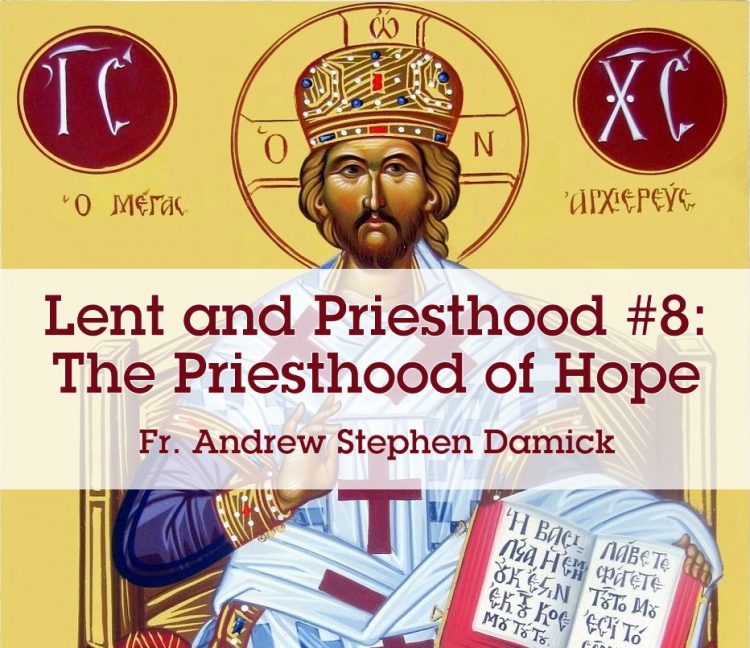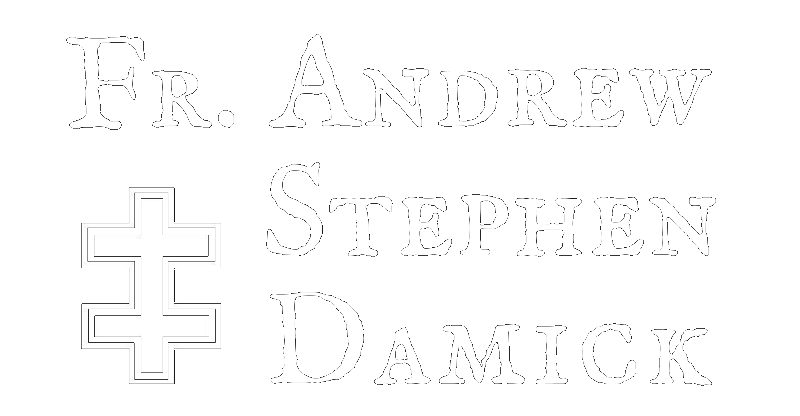
Sunday of St. John of the Ladder, March 26, 2017
Hebrews 6:13-20; Mark 9:17-31
Very Rev. Fr. Andrew Stephen Damick
In the Name of the Father and of the Son and of the Holy Spirit, one God. Amen.
Today is the eighth installment in our Lenten series on the priesthood, and we are also just three weeks away from Pascha. Today our focus comes from the epistle reading appointed for today, the fourth Sunday of Great Lent, from Paul’s epistle to the Hebrews. Paul writes that God has acted that
we might have a strong consolation, we, who have fled for refuge to lay hold of the hope that is set before us; a hope, which we have as an anchor of the soul, both sure and steadfast, and entering into “that which is within the veil,” where Jesus entered as Forerunner on our behalf, having become a High Priest “forever according to the order of Melchizedek.” (Heb. 6:18-20)
In this passage, Paul explicitly links our Christian hope, which he poetically calls “an anchor for the soul, both sure and steadfast,” with the priesthood of Jesus Christ. So we will follow his lead today and talk about how the Christian hope is expressed in the priesthood.
Foremost is the priesthood of Jesus, Who enters through the veil. We mentioned before that the priests of the Old Covenant would enter through the veil into the Holy of Holies and there offer up sacrifices for the people at the Ark of the Covenant.
This priestly act of sacrifice by Christ in the Holy of Holies brings us hope in several ways.
Probably our most immediate sense of hope is that Christ’s act there brings us forgiveness of sins. This is one of the core purposes of priestly sacrifice in the Jewish tradition, and while it is not the only thing that sacrifice does, it is one of its most basic purposes. When sacrifice was offered to God, He promised that He would forgive the sins of the people of Israel.
It is only with the coming of Christ that we see exactly why that works, however. Sacrifice was never about appeasing God. That is, it was not about—in essence—bribing God so that He would forget about sins committed against His law. Some people think that’s what spiritual life is about, that we are in a sense paying God off so that He will look the other way when it comes to our sins. But that’s not what sacrifice has to do with forgiveness.
Sacrifice brings about forgiveness because we partake of the sacrifice. Remember that with the priestly prayer over the sacrifice, God acts upon the sacrifice and charges it with His presence. And then when we receive that sacrifice back from Him, His presence touches us and changes us. In this case, the change is forgiveness. We are no longer being held accountable for our sins because God is changing us through that sacrifice. In a sense, we are no longer that person who sinned but are, in the words of Scripture, “a new creation” (2 Cor. 5:17).
So we have this hope in Christ’s priestly act not just in the sense that our sins are forgiven but in the deeper sense of how and why we are forgiven. We become a new creation in this priestly act. We become different people. The righteousness given in the act of sacrifice and partaking of that sacrifice is not “virtual reality.” We are not just treated as though we are righteous but actually become righteous in the partaking.
This gives us great reason for hope! Why? Because when I look at myself, I don’t see a righteous person. I see a sinner. And I can’t fix that myself. I’m not capable. But I can be changed, little by little, by partaking in Christ’s sacrifice. I can be changed by receiving that sacrifice and cultivating what I receive, remaining faithful to it, returning to it again and again. This gives me hope, because I am otherwise hopeless. It gives me hope, because He has provided me with something I could not provide for myself.
And this sacrifice brings me the ultimate hope—the hope of resurrection. Christ’s ultimate priestly sacrifice is the offering of Himself on the cross. He enters directly into death by being offered up as a sacrifice to death. And He alters death, making it a passage not into destruction but into life.
We partake of the sacrifice of Jesus on the cross in numerous ways, but none more immediate and powerful than in baptism and in the holy Eucharist. In baptism, we receive the power of Jesus’ death and resurrection, being initiated into His own divine life. And in the Eucharist, we are nourished on that same flesh that was crucified and raised from the dead. We are in a sense eating His death and resurrection. There is perhaps no kind of eating in which that old cliché phrase is more applicable: “you are what you eat.”
With these gifts from God to bring us into His divine life and to help us remain within it, we surely have “a hope, which we have as an anchor of the soul, both sure and steadfast.”
But look closely at one of the last phrases in this Scriptural passage. Paul is talking about the veil where Jesus passed through to offer up sacrifice. He says that it is “where Jesus entered as Forerunner on our behalf.” What does that mean, that He entered there “as Forerunner on our behalf”?
Well, what is a “forerunner”? This words most often gets applied in Orthodox tradition to John the Baptist, not to Christ. John is the Forerunner of Jesus Christ. He comes before, showing the way and announcing the coming Jesus. But here, it is Jesus Who is the Forerunner. And whose forerunner is He? He is ours!
Yes, Jesus enters as the great High Priest beyond the veil to offer up sacrifices, and He goes there so that we can go there, too. His priestly act is bound up with granting the priesthood to us, His royal priesthood.
Jesus’ priesthood is a priesthood that includes us, His adopted brothers and sisters, adopted children of the same Father. He calls us to follow Him “within the veil,” to become priests along with Him. He calls us to offer up sacrifices with Him, “spiritual sacrifices acceptable to God through Jesus Christ” (1 Pet. 2:5), as Peter says. He has sacrificed Himself, and now He asks us also to sacrifice ourselves, to present our bodies as “a living sacrifice, holy, acceptable to God” (Rom. 12:1), as Paul says elsewhere.
The Lord Jesus has entered into the veil as our forerunner, and He beckons us to follow Him. He has given us this great hope of forgiveness, of being a new creation, of resurrection, and He calls us to bring that same hope to the world. We Christians are the extension of His priesthood into this world. As John says, “as He is, so are we in this world” (1 John 4:17). The whole creation lies in expectation of the “revealing of the sons of God” (Rom. 8:19). We ourselves are the expression of His hope in the world.
What all this means is that here in the Church, we directly experience the hope that Jesus gives to us in His priestly sacrifices. It is a sure hope, a strong consolation, an anchor for the soul. We can anchor our souls in what we receive here from Him.
And it also means that we become that anchor for others. Having our hope in Jesus, we bring that hope to the world through our royal priesthood. We also offer up the sacrifice, following Him beyond the veil into the Holy of Holies, and we present even ourselves as a living sacrifice.
And what does that sacrifice give us and give the world? It gives forgiveness. It makes us a new creation. It brings us the hope of the resurrection. This is indeed the priesthood of hope.
To the High Priest Whose sacrifice is our hope, with His Father and Holy Spirit, be all glory, honor and worship, now and ever, and unto ages of ages. Amen.




Blessings Father.
In the non-denominational churches, the call for us “to follow Him “within the veil,” to become priests along with Him” came to be construed as proof that the hierarchial priesthood is no longer needed. This led to a very different interpretation of, for one, the Book of Hebrews, including the implications of being a royal priesthood. So again I thank you for this series of articles. They have been very helpful in my journey to Orthodoxy.
The non-liturgical context of low-church Protestant theology on the royal priesthood, in my opinion, does not make everyone priests but actually simply eliminates priesthood entirely.
Yes, Father, thank you. We were taught that we can “boldly” enter into the throne of grace, therefore eliminating the priesthood altogether, including we as the royal priesthood. As for life-giving sacrifice, this is reduced to Christ paying the penalty for our sins. It is an altogether different theology. You mention the prime difference… they are non-liturgical.
Thank you, Father.